





Marty Ross is a garden journalist and gardener who lives in Kansas City, MO, and Virginia’s Tidewater region. She has a community garden plot and grows lettuce and herbs in pots on her front porch.
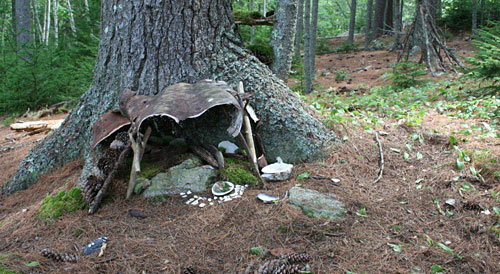
Visitors to the Coastal Maine Botanical Garden make fairy houses in secluded spots. The garden issues a few guidelines for children and adults, including the observation that successful fairy houses "look so natural they are almost hidden."
THERE'S MAGIC in a garden: Take a tiny seed, add water and soil, and it grows into a beautiful flower. Science can explain the process, but some things defy explanation — fairies, for instance.
Fairies make their homes in nature, where jaunty acorn-caps abound, mushrooms offer shelter from the rain, and gleaming mosses carpet the enchanted world of the forest. Fairy architecture relies on twigs, bits of bark, bristly pinecones, and conveniently shaped seedpods: The possibilities are infinite. People helping their friends the fairies will find no finer materials.
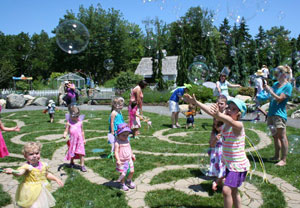
Fairy Fridays were popular all summer at the Coastal Maine Botanical Gardens. Visiting fairies, sprites, elves and wizards enjoyed fairy stories, a fairy garden puppet theater, and fairy dancing with the great bubble machine in the garden's maze. A box of fairy dress-up wings was provided for those who had forgotten their wings.
The tradition of building fairy houses is particularly well established in Maine, where children have been encouraged to use natural materials to construct charming and ephemeral fairy shelters for generations. But fairy gardens have caught on everywhere, and different interpretations of the theme are as refreshing and unpredictable as the sprites they're built for.
"We called them camps, when I was a kid," says Amanda Russell, who teaches fairy-house workshops at Coastal Maine Botanical Gardens in Boothbay, ME. "We did it all the time. We built tiny houses, with roads of rocks and sticks, a whole tiny community network."
Parents who built fairy camps as children have kept the tradition alive with their own kids, and the botanic garden expanded on it, introducing a summer series of Fairy Fridays, inviting kids to frolic in the garden wearing fairy wings. Little girls were eager early participants, "but the boys have been getting into the act," says Barbara Freeman, communications manager at the botanic garden. "We had wizards, elves and sprites — it's good that it's not just a little girl thing any more."
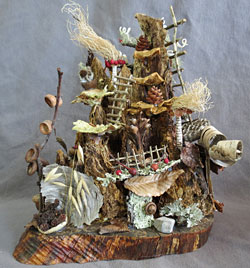
A slice from a tree trunk makes a stable base for a free-standing fairy house. Amanda Russell, who teaches fairy-house workshops at the Coastal Maine Botanical Gardens, looks for acorns, bark, seed pods, sticks, rocks, cones, and dried berries to make and decorate her fairy houses. For fairy houses made in the workshop, it's OK to use hot glue, she says.
In the botanic garden's fairy village, there are "dozens upon dozens" of fairy houses built by visitors, Freeman says, "each in its own quiet little place." Children (and adults) are welcome to build fairy houses wherever they like in the area, but they are instructed not to use any living material. No picking flowers, digging up ferns, or relocating mosses.
Otherwise, there are no rules. "There should be places where fairies can relax and eat or sleep or play," Russell says, "where they can live and work and do their thing." The miniature scale of fairy architecture "makes your brain work in a different way," she says. Tiny hemlock cones lined up in a fairy garden plot look for all the world like cabbages, she says. Her own creations make creative use of fallen leaves, rocks, and loose bits of lichen.
Russell enjoys the fun of making fairy houses, but her favorite part is gathering material on walks in the woods. Picking up ribbons of birch bark, berries, and seedpods "teaches kids to look down on the forest floor," she says. "There is a lot of beauty you don't see unless you look for it."
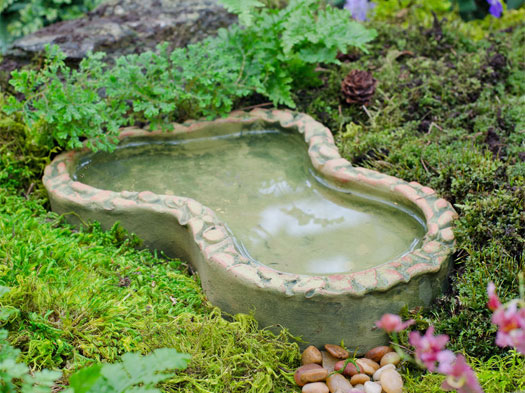
Add a little splash and pizzazz to your miniature garden with a Fairy Garden Pond. The terra cotta pond can sit on the soil surface or be slightly buried for an in-ground installation.
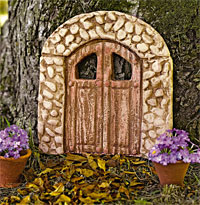
Placed near the base of a tree or tucked against a little hillside, this Fairy Garden Doorway invites fairy-sized visitors to your miniature garden.
A fairy garden in your own back yard will naturally include the plants you love. Ricki Creamer, owner of Red Cedar Gardens in Stilwell, KS, plants dwarf conifers in her fairy gardens. They're just the right scale for fairies, and give the garden year-round structure, she says. Marbles on golf tees become luminous gazing globes in a fairy garden. Polished flat pebbles make a path of stepping stones under an arbor of twigs; a small mirror becomes a sparkling reflecting pool.
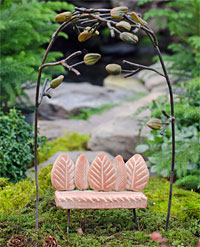
Fairy Garden Arbor and Bench: It looks as if an industrious fairy has lovingly built this arbor and bench out of twigs and leaves. Both pieces are delightful additions and perfectly sized for your miniature garden.
Creamer likes to plant herbs in her fairy gardens, especially fragrant herbs. Fairies love to dance on the tiny leaves of thyme, releasing its fragrance, she says. She plants violas and calibrachoa as shrubbery around her fairy houses, and grows lavender in fairy flowerbeds. Just keep your scissors handy, Creamer says, and snip plants to keep them from spreading out of bounds. "Fairy gardens require work, just on a smaller scale," she says.
When Creamer's grandchildren visit, the fairy garden is their favorite place. They pinch the herbs and savor the fragrance, and try to find the fairies' hiding places in the foliage. Sometimes they notice that fairies have been busy mending their twig fences or rearranging the garden furniture. You may never actually see the fairies, Creamer says, but you can sometimes feel them whisk by your face, like a warm breeze on a soft summer day. That lets you know that they feel at home.
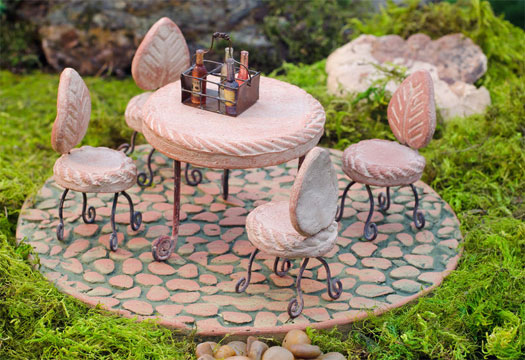
Fairy Garden Dining Set and Patio: So charming, you'll wish this little patio and dining set were sized for you! The patio resembles hand-laid stones that have become mossy with age and forms a perfect base for miniature furniture.
Copyright © www.100flowers.win Botanic Garden All Rights Reserved